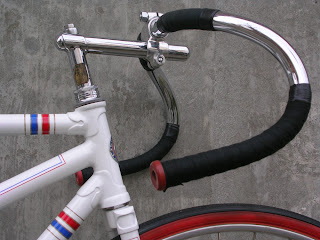The other day, I saw a tandem propped against someone's hedges
It's a Motobecane tandem from, as best as I can tell, some time in the late 1970's or early 1980's. I am always surprised to see a tandem, much less anyone riding one. But it was even more unusual to see one after the cycling season has passed its peak.
Anyone who drives in New York will tell you that parking is one of the most difficult things about life in this city. I think it's just as true for tandems as it is for cars. Actually, parking a bicycle built for two may actually be even more difficult than parking a car built for four. After all, tandems don't fit very well in spaces where people park regular bikes. And the spaces in which most New Yorkers live don't leave much room for a tandem.
I've ridden a tandem twice in my life. The first time was, in fact, around this time of year. I rode with a group that took rides to various ethnic neighborhoods in this city to sample foods and restaurants. A young blind woman wanted to ride with them, but she needed someone to ride the front of a tandem the Light House supplied. Enter me.
The bike was a single speed Schwinn: heavy, but not a bad bike. As I recall, it's what the bike rental places in Central Park offered. So, while it wasn't the most responsive thing in the world, at least it didn't "fishtail" in the rear, as some tandems are prone to do.
I think my story-telling skills were more important than my bike-riding prowess for that woman. I gave her a running narrative of the neighborhoods through which we rode and explained why we were riding them.
After a while, I found myself sad and frustrated because I had to explain all sorts of things most of us take for granted. For example, when we rode by the brownstones of Park Slope and Carroll Gardens, I realized she had no idea of what they looked like. She didn't even know about red, brown or any other color.
Unfortunately for that young woman, I didn't do quite as well as the narrator did at the end of Raymond Carver's Cathedral.
Then again, that narrator wasn't pedaling and balancing the front of a tandem!
It's a Motobecane tandem from, as best as I can tell, some time in the late 1970's or early 1980's. I am always surprised to see a tandem, much less anyone riding one. But it was even more unusual to see one after the cycling season has passed its peak.
Anyone who drives in New York will tell you that parking is one of the most difficult things about life in this city. I think it's just as true for tandems as it is for cars. Actually, parking a bicycle built for two may actually be even more difficult than parking a car built for four. After all, tandems don't fit very well in spaces where people park regular bikes. And the spaces in which most New Yorkers live don't leave much room for a tandem.
I've ridden a tandem twice in my life. The first time was, in fact, around this time of year. I rode with a group that took rides to various ethnic neighborhoods in this city to sample foods and restaurants. A young blind woman wanted to ride with them, but she needed someone to ride the front of a tandem the Light House supplied. Enter me.
The bike was a single speed Schwinn: heavy, but not a bad bike. As I recall, it's what the bike rental places in Central Park offered. So, while it wasn't the most responsive thing in the world, at least it didn't "fishtail" in the rear, as some tandems are prone to do.
I think my story-telling skills were more important than my bike-riding prowess for that woman. I gave her a running narrative of the neighborhoods through which we rode and explained why we were riding them.
After a while, I found myself sad and frustrated because I had to explain all sorts of things most of us take for granted. For example, when we rode by the brownstones of Park Slope and Carroll Gardens, I realized she had no idea of what they looked like. She didn't even know about red, brown or any other color.
Unfortunately for that young woman, I didn't do quite as well as the narrator did at the end of Raymond Carver's Cathedral.
Then again, that narrator wasn't pedaling and balancing the front of a tandem!






